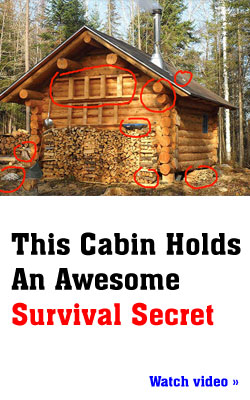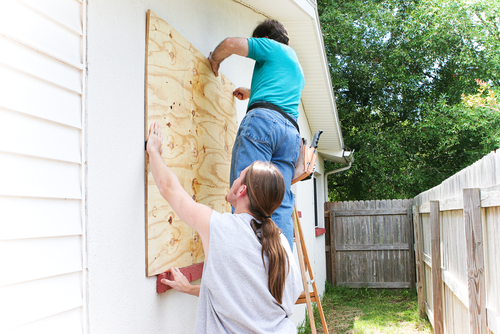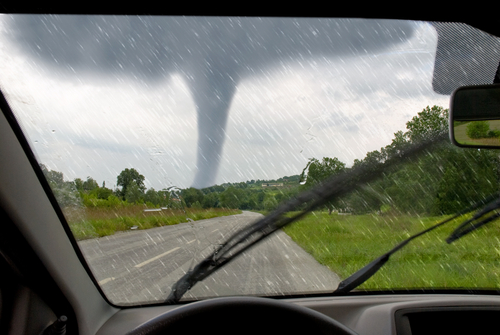Indians once referred to the mighty tornado as the “Finger of God” because it has the power to spare or destroy.
Tornadoes can occur in every state and has the capacity to strike with little or no warning. The damage from a tornado results from high wind velocity and wind blown debris. Because they can occur in any state and also accompany tropical storms and hurricanes as they move onto land, each family should make preparations before a tornado strikes.
 Tornado Facts:
Tornado Facts:
- They may strike quickly, with little or no warning.
- They may appear nearly transparent until dust and debris are picked up or a cloud forms in the funnel.
- The average tornado moves Southwest to Northeast, but tornadoes have been known to move in any direction.
- The average forward speed of a tornado is 30 mph, but may vary from stationary to 70 mph. The maximum speed is over 300 mph.
- Waterspouts are tornadoes that form over water.
- Tornadoes are most frequently reported east of the Rocky Mountains during spring and summer months.
- Peak tornado season in the southern states is March through May; in the northern states, it is late spring through early summer.
- Tornadoes are most likely to occur between 3 pm and 9 pm, but can occur at any time.
Tornadoes are categorized based on sustained wind damage:
- F-0 40-72 mph Chimney damage, tree branches broken
- F-1 73-112 mph Mobile homes pushed off their foundations or overturned
- F-2 113-157 mph Considerable damage. Mobile homes demolished. Trees uprooted
- F-3 158-205 mph Roofs and walls torn down. Trains overturned. Cars thrown.
- F-4 207-260 mph Well constructed walls leveled
- F-5 261-318 mph Homes lifted off foundations and carried considerable distances. Cars thrown as far as 100 meters.
What’s the Difference Between a Watch and a Warning?
Tornado Watch – Tornadoes are possible. Remain alert for approaching storms. Watch the sky and stay tuned to NOAA (National Oceanic and Atmospheric Administration) Weather Radio, commercial radio or television for information.
Tornado Warning – A tornado has been sighted or indicated by weather radar. Take shelter immediately.
Signs of a Tornado
Always be on alert when a strong storm is approaching – with the right conditions it could turn into a tornado. Look for these additional signs:
- Dark, often greenish sky
- Large hail
- A large, dark, low-lying cloud (particularly if rotating)
- Loud roar, similar to a freight train.
If you see approaching storms or any of the danger signs, be prepared to take shelter immediately.
Preparing for a Tornado
These swirling vortexes of destruction can cause fatalities and destroy in a matter of seconds with paths of up to 1 miles in width or more. Therefore it is in one’s best interest to prepare beforehand. Pre-planning is critical in helps your family react more quickly and fluidly to the situation at hand. Sitting down as a family to discuss protocols, procedures and what they should expect during a tornado will help them grasp the severity of the situation.
Make a Plan
The first thing you should do to prepare for any emergency is to sit down with your family and create a preparedness plan that includes pertinent contact information, alternative emergency locations, and have important papers safely put away or downloaded onto a flash drive for easy carry.
Sometimes certain preparedness subjects can be hard for small children to understand. Children have a psychological need for security and stability therefore, prepare your children by building their natural resilience to these situations. Read more here.
Further, if you store food and water for emergencies, plan to have meals that will require minimum fuel or electricity usage. There are many layers of a preparedness pantry, so depending on how long your want to prepare for, you may want to start off with shelf stable foods such as canned goods, just add water meals, freeze dried meals, etc.
For a calculator for how much food you need to be prepared, click here. You must anticipate that you will be without power until restoration efforts begin, so keep easy to make meals in mind. Also, don’t forget to store lots of water. You must have water for drinking, food preparation and for sanitation issues.
Communications is an important aspect of tornado preparedness.
In any emergency, always listen to the instructions given by local emergency management officials.
Sheltering in Place
Your family could be anywhere when a tornado strikes–at home, at work, at school, or in the car. Discuss different shelter areas to go to during a tornado. Moreover, talk with members of how they can protect themselves from flying and falling debris.
According to the American Red Cross, “the key to surviving a tornado and reducing the risk of injury lies in planning, preparing, and practicing what you and your family will do if a tornado strikes. Flying debris causes most deaths and injuries during a tornado. Although there is no completely safe place during a tornado, some locations are much safer than others.”
At Home
Pick a place in the home where family members can gather if a tornado is headed your way. One basic rule is AVOID WINDOWS AND MIRRORS. An exploding window can injure or kill.
The safest place in the home is the interior part of a basement. If there is no basement, go to an inside room, without windows, on the lowest floor. This could be a center hallway, bathroom, or closet.
For added protection, get under something sturdy such as a heavy table or workbench. If possible, cover your body with a blanket, sleeping bag, or mattress, and protect your head with anything available–even your hands. Avoid taking shelter where there are heavy objects, such as pianos or refrigerators, on the area of floor that is directly above you. They could fall though the floor if the tornado strikes your house.
If you live in a mobile home, bear in mind that these do not offer adequate shelter. They can turn over from high wind velocities. If you live in mobile home, evacuate immediately and go to the lowest floor of a sturdy, nearby building or a storm shelter from a tornado. Get out immediately and go to the lowest floor of a sturdy, nearby building or a storm shelter.
Car Safety
The least desirable place to be during a tornado is in a motor vehicle. Cars, buses, and trucks are easily tossed by tornado winds. DO NOT TRY TO OUTRUN A TORNADO IN YOUR CAR. If you see a tornado, stop your vehicle and get out. Do not get under your vehicle.
If you find yourself in a car when a tornado is hitting follow these safety protocols:
- Immediately get into a vehicle, buckle your seat belt and try to drive to the closest sturdy shelter.
- If your vehicle is hit by flying debris while you are driving, pull over and park.
- Stay in the car with the seat belt on. Put your head down below the windows; cover your head with your hands and a blanket, coat or other cushion if possible.
- If you can safely get noticeably lower than the level of the roadway, leave your car and lie in that area, covering your head with your hands
- Do not get under an overpass or bridge. You are safer in a low, flat location.
- Never try to outrun a tornado in urban or congested areas in a car or truck. Instead, leave the vehicle immediately for safe shelter.
- Watch out for flying debris. Flying debris from tornadoes causes most fatalities and injuries.
Outdoors
If you are caught outside during a tornado and there is no adequate shelter immediately available, do the following:
- Avoid areas with many trees.
- Avoid vehicles.
- Lie down flat in a gully, ditch, or low spot on the ground.
- Protect your head with an object or with your arms.
Long-Span Buildings
A long-span building, such as a shopping mall, theater, or gymnasium, is especially dangerous because the roof structure is usually supported solely by the outside walls. Most such buildings hit by tornados cannot withstand the enormous pressure. They simply collapse.
If you are in a long-span building during a tornado, stay away from windows. Get to the lowest level of the building–the basement if possible–and away from the windows.
If there is no time to get to a tornado shelter or to a lower level, try to get under a door frame or get up against something that will support or deflect falling debris. For instance, in a department store, get up against heavy shelving or counters. In a theater, get under the seats. Remember to protect your head.
Office Buildings, Schools, Hospitals, Churches, and Other Public Buildings
Extra care is required in offices, schools, hospitals, or any building where a large group of people is concentrated in a small area. The exterior walls of such buildings often have large windows.
If you are in any of these buildings:
- Move away from windows and glass doorways.
- Go to the innermost part of the building on the lowest possible floor.
- Do not use elevators because the power may fail, leaving you trapped.
- Protect your head and make yourself as small a target as possible by crouching down.
Shelter for People with Special Needs
Advance planning is especially important if you require assistance to reach shelter from an approaching storm.
If you are in a wheelchair, get away from windows and go to an interior room of the house. If possible, seek shelter under a sturdy table or desk. Do cover your head with anything available, even your hands.
If you are unable to move from a bed or a chair and assistance is not available, protect yourself from falling objects by covering up with blankets and pillows.
If you are outside and a tornado is approaching, get into a ditch or gully. If possible, lie flat and cover your head with your arms.
Injuries from a Tornado
Injuries sustained from a tornado can be serious and life threatening. Do not attempt to move seriously injured people unless they are in immediate danger of further injury. Get medical assistance immediately. If someone has stopped breathing, begin CPR if you are trained to do so. Stop a bleeding injury by applying direct pressure to the wound. Have any puncture wound evaluated by a physician.
If you are trapped, try to attract attention to your location.
Reconnecting with Family Members
When disasters are concerned, things can go awry very quickly. And in some cases, families can become separated. When a family is separated from one another, providing pertinent information to medical personnel or first responders becomes more challenging due to heightened emotions from the stressful situation.
Learn how to create personal ID (Identity Document) cards for children and to have essential information stored for this situation. After a disaster, let your family and friends know that you are safe and well to bring peace of mind to concerned family members. This website is designed to help make that communication easier.
Emotionally reconnecting with family members can also be difficult. Due to the trauma involved in surviving a natural disaster, some children will exhibit symptoms of post traumatic stress. Also learn how family members can help their child get through this difficult time.
To conclude, the best way to prepare for a tornado is to frequently check supplies and have family members practice where to go and what to do during a tornado. Practice makes perfect and helps to calm fears when and if this natural disaster occurs.
Source:
This information has been made available by Ready Nutrition and Tess Pennington












Dorothea Degenhardt | May 23, 2013
|
Thank you for the good information.
Dorothea
Don Turnblade | May 23, 2013
|
I begin to wonder if a motorcycle helmet might be the single most useful survival equipment.
In a tornado, head injury protection from flying objects needs to be prevented.
In a flood, it is injury to the head by objects that kills people, they seldom drown.
In an Earthquake, its collapsing objects from the ceiling first, then being trapped and finally fire.
Mad Max with a Helmet.
jane reeves | May 23, 2013
|
There is no substatute for being prepared. I am from Oklahoma. We are taught from kindergarden what to do. In Texas not so much. True Texas doesn’t experiance tornados as much as OK. But when they do the difference shows. I have about 30 days, supplies ready. My family knows what to do…
Dennis | March 6, 2019
|
Do you have a tornado shelter?They come in different sizes,above and below ground. You should put at least some of your supplies in it. The tornado will take everything that isn’t nailed down or underground.
barry norris | May 23, 2013
|
Please include preparation planning advice for caring for your pets and livestock, as they can be extremely difficult to manage during such emergencies. Thank you for the excellent information you have given.
Milos Leubner | May 24, 2013
|
What is it going to take for the people to finally start building every structure with small, concrete basement with attachable solid cover at the top? It would have multiple uses ,such as cooling in the summer and such ,at relatively low cost .8′ x 10′ concrete hole will save a lives of the whole family and the gold fish to.
Linda Mullin | May 24, 2013
|
I was at a conference about the Joplin tornado and the ER staff doctor said most of the children that died, died from blunt force trauma head injuries. He showed the video of people streaming into the ER when around the corner proudly marching in was a four year old wearing only his white jock underpants and his baseball helmet. The tornado took all his clothes. His older brother was fast after him. Their mom put the helmets on them.
Connor Webb | May 26, 2013
|
I have been reading what to do in the event of a tornado and it looks like they’ve changed the rules on being in your car. You should be using your vehicle to try and get away from the tornado and then stay in the vehicle if you’re about to be struck. You want to stay buckled and crouch below the windows with your hands (or other object) covering your head. Apparently there are many safety concerns with the ditch, including electrocution and snake bites that have led storm chasers to avoid that option.
http://www.nws.noaa.gov/om/severeweather/resources/ttl6-10.pdf
http://www.redcross.org/prepare/disaster/tornado
Pingback:How to Survive and Signal When Trapped | May 19, 2014
|
Pingback:Bug-Out Backup: How to Find Emergency Shelter Underground | May 22, 2014
|
Pingback:Bug-Out Backup: How to Find Shelter Undergound | TheSurvivalPlaceBlog | May 23, 2014
|
Pingback:Bio Prepper | Bug-Out Backup: How to Find Shelter Undergound | June 1, 2014
|
Pingback:When Summer Turns into Disaster: Prepping for Storms | June 29, 2014
|
Pingback:When Summer Turns into Disaster | TheSurvivalPlaceBlog | July 1, 2014
|
Pingback:Survival Toolkits for Your House | SurvivoPedia | August 14, 2014
|
Pingback:A Basic Guide To Shelters | Survival skills, survival guns, survival guide | January 14, 2015
|
Pingback:When Summer Turns into Disaster | The Prepper Dome | May 1, 2015
|
Pingback:When Summer Turns Into Disaster | August 11, 2015
|
Pingback:A Basic Guide To Shelters - Prepper Ways | February 12, 2016
|
Pingback:10 Secret Ways To Turn The Panic Room Into A Bunker | Survivopedia | September 12, 2016
|